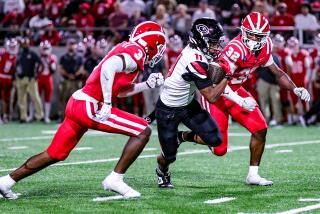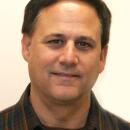Campus Big Men Getting Bigger
Consider a weighty issue, one heavy on the minds of football coaches--not to mention any Taft High player forced to line up across from either of Dorsey’s 390-pound tackles last week.
Kids are growing up larger and larger. Scientists say it’s true. There’s anecdotal evidence too.
Gabe Kapler, the buff Detroit Tigers’ rookie from Taft High, barely fit in the dugout at 87-year-old Tiger Stadium this year. The 6-foot-2 Kapler--and several of his Tiger teammates--routinely bumped their heads on the concrete ceiling, something that never concerned bantams Ty Cobb or Nap Lajoie, Hall of Fame credentials notwithstanding.
Comerica Park, the Tigers’ digs beginning next season, presumably will be spacious enough to handle the 21st Century Man.
Proof is also found on high school football rosters. About 30 players from area schools weigh 300 pounds or more. Any offensive line worth its pregame protein averages at least 220 pounds per man-child.
Even small schools suit up big linemen. La Canada, a 1-2 team competing in Southern Section Division X, averages 285 pounds from tackle to tackle.
Twenty years ago a line that averaged 200 pounds was considered behemoth.
Where have you gone Dean Wolff and Paul Howell, the 165-pound starting guards on my 1974 Newbury Park High team? They could block with the best. Today, they’d be lucky to make the kickoff team.
Improved nutrition, weight training and supplements such as creatine have combined with genetics to produce whoppers in assembly-line fashion. Can you say “super-size it?”
Yet many 300-pounders spend the season taking up more than their share of the bench. All they block is someone’s view from the stands.
“Speed and quickness are the No. 1 things you look for in any football player, linemen included,” said Tom Harp, co-coach at Granada Hills. “Naturally, you don’t want a 150-pound guy. But a lot of times the 300-pound guys aren’t quick enough to block faster defensive linemen.”
A few are huge and quick. College recruiters have no trouble locating them.
Keith Holt (6-5, 300) of Westlake, Adrian Ayala (6-6, 313) of St. Bonaventure, and Gilbert Sandoval (6-1, 300) and Hector Sanchez (6-4, 340) of Sylmar fit (snugly) into this category.
But most 16- or 17-year-olds who spin the scales to 300 pounds are, well, we’ll let Harp say it. . .
“They are carrying too much fat,” he said.
Cleveland has two 300-pound linemen with potential as prodigious as their waistlines--junior Victor Gomez (6-4, 310) and sophomore Andre Berkeley (6-5, 318).
“It’s going to take time,” Coach Bill Paden said. “It takes more than size to make a football player.
“But they have something that can’t be taught--size.”
Lining up across from an opponent as big as Costco can be daunting. The assignment isn’t treated lightly.
“You don’t want to get tangled up with them, but if you use a move and have quick feet you can get around them,” said Lamar Maxie, a 180-pound Taft defensive end who spent last Friday night dodging the blocks of Rafael Liggins (6-8, 390) and Travis Nelson (6-6, 390) of Dorsey.
Hard work and proper nutrition can eventually transform a fat kid into a college specimen. Washington’s 340-pound tackle Elliot Silvers, who attended Agoura High, is a prime example.
Hard work is the key to gaining the respect of teammates. When a 300-pound player completes the same drills as a guy half his size, suddenly fat is phat.
“They get no abuse on our team,” Harp said. “They are respected because they do the same conditioning as everyone else.
“It’s funny, when we run long distances at the end of practice, those kids are last but everybody is cheering for them.”
More to Read
Get our high school sports newsletter
Prep Rally is devoted to the SoCal high school sports experience, bringing you scores, stories and a behind-the-scenes look at what makes prep sports so popular.
You may occasionally receive promotional content from the Los Angeles Times.







